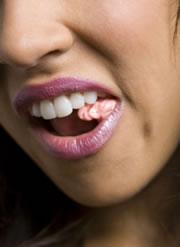 Those predisposed to mouth and stomach cancers could one day have a chewy medicine.© Getty
Those predisposed to mouth and stomach cancers could one day have a chewy medicine.© GettyIt freshens breath, protects teeth and even, if you believe the commercials, makes you immensely popular. But Finnish researchers are hoping that chewing gum could soon pull off an even more ambitious trick: helping to stave off cancer.
They have made a gum containing a compound that mops up a chemical called acetaldehyde, which has been linked to cancers of the mouth, oesophagus and stomach. The active ingredient, called cysteine, is slowly released through chewing the gum.
The anti-cancer chew could help those most at risk, such as smokers and heavy drinkers, suggests Mikko Salaspuro of the University of Helsinki, who developed the idea with his colleague Martti Marvola. Smoking and drinking are linked to up to 80% of these cancers in developed countries.
Straight to source
Smoke and alcohol both raise the levels of acetaldehyde in the mouth and upper digestive tract. Cysteine, a building block of proteins, reacts with the compound to take it out of harm's way. But simply eating protein-rich food, or taking a cysteine pill, doesn't target the right areas, Salaspuro says.
"Cysteine in foods is normally released in the small intestine," he says. "But that is too late — the point is to release it in the saliva or the stomach."
The new gum aims to deliver cysteine to where it is needed. The researchers have already shown that a slow-release cysteine tablet, nursed under the lip, eliminates acetaldehyde from the mouth.
“Cysteine in foods is normally released in the small intestine. But that is too late - the point is to release it in the saliva or the stomach.”
Mikko Salaspuro
University of Helsinki
The idea, presented at the International Congress on Oral Cancer in Grado, Italy, is being developed by a Finnish company called Biohit. "It's very easy to make the preparation," says Salaspuro, "but they are still testing how it tastes."
Chew it over
But health experts warn that, even if successful, the gum will be no substitute for cleaning up your act. The best way to avoid cancer is not to smoke, says Kat Arney, a spokeswoman for Cancer Research UK in London.
Acetaldehyde is just one of a suite of cancer-causing chemicals in cigarette smoke. The gum can't address all of these, nor does it combat the damage that breathing in smoke does to the lungs.
Lung cancer accounts for some 25% of all cancer deaths, says Arney. And of those, 90% are down to smoking. "Chewing gum is not going to help that," she says.
"It's a nice idea, and I'm sure people would buy it," she says. "But it seems a bit cynical — a bit of a sop to our quick-fix culture."
Acid test
Although cysteine reduces acetaldehyde levels in the mouth, it will take longer to establish whether this translates into fewer cancer cases. Salaspuro says that such tests are planned, but because of the nature of cancer, will take a long time to produce results.
ADVERTISEMENT
He hopes that the gum could also help those at risk from their genes rather than their lifestyles. Japanese people, for example, are more susceptible to the effects of acetaldehyde because they lack a key enzyme that breaks it down. And sufferers of achlorhydria, a condition in which the stomach does not produce enough acid, might also use the gum to reduce their susceptibility to gastric cancer.
Visit our onthisthegumthatfigh.html">newsblog to read and post comments about this story.
University of Helsinki
